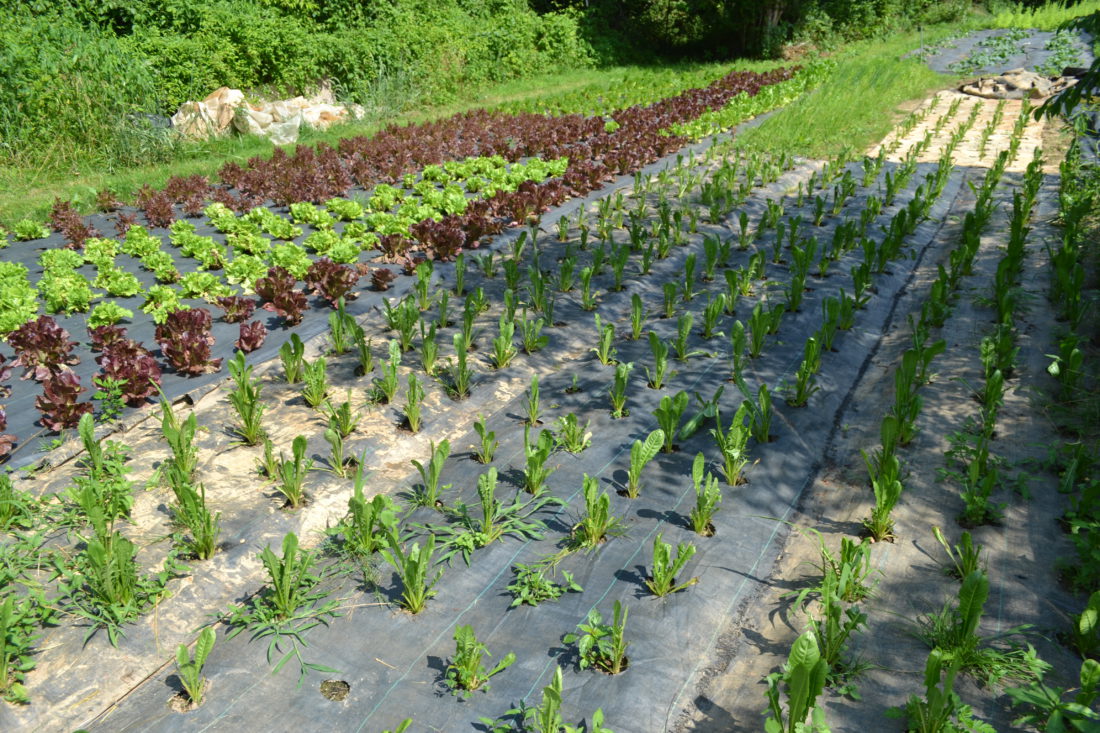BY NICOLE DELCOGLIANO
Now that a year has passed since the pandemic became a hard reality, I’ve been reflecting on the toll it’s taken on our local food and farm landscape. Like everybody else, farmers scrambled to make sense of it all. And when grocery store shelves began to get bare, shoppers wondered why there was suddenly no ground beef and shortages of certain vegetables. Why had we gone from a cornucopia of food to an empty basket?
We didn’t know if or when our local farmers markets and restaurants would reopen, meaning farmers didn’t know where or when they’d be able to sell their products.
By March, farms are already in motion: First seeds are getting planted outside, farm animals are starting to have babies, and most of the planning has already been done. Many local farms start hiring employees during the winter. The pandemic, however, left farms that were already operating on very slim margins concerned about potential exposure risks and reluctant to hire workers they weren’t sure they could pay.

Sustainability is a high priority for many small-scale farms in Western North Carolina. But sustainability has economic and social as well as environmental dimensions: It affects not only how we farm but how we design our businesses. And economic sustainability, in turn, impacts both who farms and how well they can be paid.
Finding skilled farm laborers has always been a challenge, but the pandemic has made it even harder by exacerbating worker safety and availability issues. Federal immigration policy and a general climate of fear made migratory workers more fearful of moving around and increased the risk of bringing employees or apprentices onto farms.
Invisible workers
The nation’s food system — including production, harvest, packaging, distribution and preparation — is complex, with many invisible parts that most folks never think about until those products disappear. Few people truly understand how it all works or who does that work.
The pandemic has highlighted the sustainability challenges small farms face, particularly in terms of the labor equation. Because behind those empty shelves and panic buying are thousands of farmworkers — many of them immigrants, often undocumented — who labor tirelessly to grow, harvest, pack and distribute food to consumers while making less than a living wage or even the minimum wage.
Most WNC farms are small by U.S. Department of Agriculture standards. Many are run by just one or two people, and crews on organic farms average 15 people or fewer. Local farmers employ various strategies to reduce negative ecological impacts on the land and water under their stewardship, but all that costs money.
Meanwhile, farms are also businesses, and unless they turn a profit, they won’t stay in business long. Each decision made on a small farm involves many factors, including both how to get the work done and who will do it. Farmers are no strangers to hard work, yet farming even a few acres may be more than one or two people can handle.
To be sustainable, small farms must be diversified, efficient and adaptable, but that requires solid know-how; reliable, skilled laborers; and the revenue to pay them well.
Labor logistics
Some farmworkers live on-site, receiving room and board plus a cash stipend. This model immerses them in a specialized way of life, imparting not only farming know-how but all the ins and outs of running a farm business. Many newer WNC farmers apprenticed for a number of years before striking out on their own. The Organic Growers School’s Apprentice Link service lists farms that provide mentorship/education and currently need workers.
Other farms pay hourly wages but no lodging. Thatchmore Farm in Leicester, launched in 1987 by Tom Elmore and Karen Thatcher, pays workers under $10 an hour, with additional compensation in the form of farm produce. But their three- to four-person farm crew also receives daily hands-on training. Tom, a beacon of sustainability in the WNC farming community, was the Organic Growers School’s Organic Educator of the Year in 2017. He says he’s working toward paying higher wages, but current federal policies, artificially low food prices and the resulting consumer expectations make this difficult.
Caught in a bind
U.S. households spend a smaller percentage of their income on food than people in other industrialized nations, and consumers have gotten used to prices that don’t reflect the true cost of production. Even though Tom sells at the North Asheville Tailgate Market, where consumers are willing to pay a premium for fresh, safe, local food, he says he’d have to charge up to $6 a pound for his greenhouse tomatoes in order to increase the net profit. And set against a national landscape of cheap food prices, that simply wouldn’t work.
Wendy Noel and her husband, Graham, co-own Dry Ridge Farm, a livestock operation in Madison County. In March 2020, she says, “We delayed hiring because we were uncertain financially, and we had so much other work to do redirecting eggs from wholesale to retail, it felt better for us to figure that out ourselves.”
As a result of that shift, their overall revenue increased, and they did eventually hire a part-time worker whose hourly rate is close to a living wage. The cost of on-site housing is deducted from those wages.
Ultimately they’d like to be able to pay all their workers $15 an hour. Yet Noel also points out that, after nine years, “We’ve just gotten to where we’re able to pay ourselves a starting salary similar to an office job. Anything we pay an employee comes out of what we pay ourselves.”
The big squeeze
In the end, she says, “If people ate less meat and paid more for it, we’d be in a far better situation financially.” The industrial meat system is fragile, unsustainable and unjust, she maintains. This was underscored when processing plant workers got sick with COVID-19, triggering shortages.
Steven Beltram and his partners at BNH Enterprises in Old Fort find themselves in a somewhat different position. Now in their third year of organically farming up to 70 acres, they run crews of as many as 20 people, most of them immigrants or migrant laborers. Contracted through a third party, those workers often average $15 an hour or more. But finding “enough people to do the work who know how to do it,” he says, is “the biggest challenge in the specialty crop business,” and in recent years, it’s gotten even harder.
Ideally, he’d like to “create an opportunity for the same individuals to work here year after year, to develop a sense of buy-in and be invested in the future of BNH.” But that won’t be possible without changes in federal law.
In the meantime, local farmers remain squeezed between unjust policies and artificially low prices on the one hand, and a shortage of skilled labor that’s exacerbated by immigration restrictions on the other hand. Caught in the middle, our small farmers struggle to balance wages with prices the market will bear, while treating workers fairly.
If more consumers shifted a portion of their buying to local farms and markets, it would increase those farms’ profit, enabling them to pay their workers (and themselves) better. And that would go a long way toward making WNC farms more sustainable.
Nicole DelCogliano is a farmer and co-owner of Green Toe Ground farm in Burnsville. She’s been passionately educating beginning farmers for over 20 years, the last six at the Organic Growers School.




Before you comment
The comments section is here to provide a platform for civil dialogue on the issues we face together as a local community. Xpress is committed to offering this platform for all voices, but when the tone of the discussion gets nasty or strays off topic, we believe many people choose not to participate. Xpress editors are determined to moderate comments to ensure a constructive interchange is maintained. All comments judged not to be in keeping with the spirit of civil discourse will be removed and repeat violators will be banned. See here for our terms of service. Thank you for being part of this effort to promote respectful discussion.